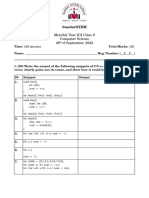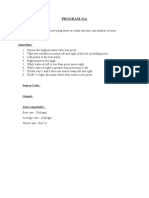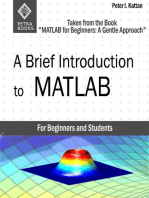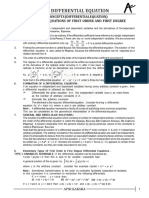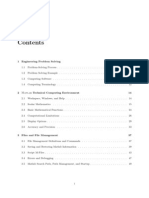ECM6Lecture11cVietnam 2014
ECM6Lecture11cVietnam 2014
Uploaded by
duyvuCopyright:
Available Formats
ECM6Lecture11cVietnam 2014
ECM6Lecture11cVietnam 2014
Uploaded by
duyvuOriginal Description:
Original Title
Copyright
Available Formats
Share this document
Did you find this document useful?
Is this content inappropriate?
Copyright:
Available Formats
ECM6Lecture11cVietnam 2014
ECM6Lecture11cVietnam 2014
Uploaded by
duyvuCopyright:
Available Formats
ECM6 Computational Methods :
Slide 1 of 5
Lecture 11c
Nonlinear Regression
Brian G. Higgins
Department of Chemical Engineering & Materials Science
University of California, Davis
April 2014, Hanoi, Vietnam
ECM6Lecture11cVietnam_2014.nb
Overview of Nonlinear Regression
There are times when we need to determine parameters in a model that appear nonlinearly.
Recall in our previous discussions on linear regression we were always able to reduce the problem to
Y = a0 + a1 X1 + a2 X2 + + aN XN
Here the unknown parameters ai appear linearly in the regression model. But this is not always the case
For example, suppose we have vapor pressure versus temperature data that we want to use to determine the coefficients in an Antoine equation:
P HTL = Exp a -
b
T+c
Note that we cannot transform this equation into a linear model. Nevertheless, we can still define a least
squares solution to determine the parameters. That is
M
E2 HPL = HP HTk L - Pk L2
k=1
and then look for the parameters such that E2 HPL is minimized. Again the local minimum with respect to
the parameters a, b, c is given by
P
a
= 0,
P
b
= 0,
P
c
=0
These equations are not linear, however. Nonetheless, we can still solve them using a Newton iteration
method. Let us consider the following example:
ECM6Lecture11cVietnam_2014.nb
A Nonlinear Regression Model
Consider the following example
We are given temperature (K) versus vapor pressure (kPa) data for n-Hexane:
88280, 8.65589<, 8290, 13.9557<, 8300, 21.6206<, 8310, 32.5923<,
8320, 47.9046<, 8330, 68.2326<, 8340, 94.8424<, 8350, 129.398<,
8360, 172.859<, 8370, 226.84<, 8380, 292.981<, 8390, 372.821<, 8400, 468.262<<
We would like to fit this data to the Antoine model given by (14). As before we define the data and the
necessary functions to extract out the temperature and vapor pressure values from the data list. We
also define our Antoine model, and the expression of the square of the errors E2
Mathematica Code
In[1]:=
data = 88280, 8.615<, 8290, 13.866<, 8300, 21.696<, 8310, 32.588<, 8320, 47.845<,
8330, 68.14697<, 8340, 94.879<, 8350, 129.325<, 8360, 172.806<,
8370, 226.774<, 8380, 292.951<, 8390, 372.788<, 8400, 468.248<<;
Functions to extract the data
In[6]:=
T@i_D := data@@i, 1DD; P@i_D := data@@i, 2DD; M = Length@dataD;
Mathematical Model: Antoine Equation
In[7]:=
Antoine@T_D := ExpBa -
b
T+c
Sum of Squares function
M
In[8]:=
E2 @g_, M_D := Hg@T@iDD - P@iDL2
i=1
Here is what the square of the errors E2 looks like using the Antoine Model:
In[9]:=
E2 @Antoine, MD
2
Out[9]=
J- 8.615 + a- 280+c N + J- 13.866 + a- 290+c N + J- 21.696 + a- 300+c N +
2
J- 32.588 + a- 310+c N + J- 47.845 + a- 320+c N + J- 68.147 + a- 330+c N + J- 94.879 + a- 340+c N +
b
J- 129.325 + a- 350+c N + J- 172.806 + a- 360+c N + J- 226.774 + a- 370+c N +
J- 292.951 + a- 380+c N + J- 372.788 + a- 390+c N + J- 468.248 + a- 400+c N
Then we take the derivative of E2 with respect to the parameters a,b,c:
ECM6Lecture11cVietnam_2014.nb
In[11]:=
eqns = 8D@E2 @Antoine, MD, aD 0, D@E2 @Antoine, MD, bD 0, D@E2 @Antoine, MD, cD 0<
b
Out[11]=
:2 a- 280+c J- 8.615 + a- 280+c N + 2 a- 290+c J- 13.866 + a- 290+c N + 2 a- 300+c J- 21.696 + a- 300+c N +
b
2 a- 310+c J- 32.588 + a- 310+c N + 2 a- 320+c J- 47.845 + a- 320+c N + 2 a- 330+c J- 68.147 + a- 330+c N +
b
2 a- 340+c J- 94.879 + a- 340+c N + 2 a- 350+c J- 129.325 + a- 350+c N + 2 a- 360+c J- 172.806 + a- 360+c N +
b
2 a- 370+c J- 226.774 + a- 370+c N + 2 a- 380+c J- 292.951 + a- 380+c N +
2 a- 390+c J- 372.788 + a- 390+c N + 2 a- 400+c J- 468.248 + a- 400+c N 0,
b
2 a- 280+c J- 8.615 + a- 280+c N
-
280 + c
b
H290 + cL2
H300 + cL2
H320 + cL2
b
2 b a- 340+c J- 94.879 + a- 340+c N
+
H330 + cL2
2 b a- 330+c J- 68.147 + a- 330+c N
H360 + cL2
b
2 b a- 370+c J- 226.774 + a- 370+c N
2 b a- 380+c J- 292.951 + a- 380+c N
+
H370 + cL2
2 b a- 360+c J- 172.806 + a- 360+c N
+
H350 + cL2
H340 + cL2
2 b a- 350+c J- 129.325 + a- 350+c N
H380 + cL2
b
2 b a- 390+c J- 372.788 + a- 390+c N
H390 + cL2
2 b a- 300+c J- 21.696 + a- 300+c N
2 b a- 320+c J- 47.845 + a- 320+c N
+
H310 + cL2
2 b a- 290+c J- 13.866 + a- 290+c N
2 b a- 310+c J- 32.588 + a- 310+c N
0,
400 + c
b
2 b a- 280+c J- 8.615 + a- 280+c N
2 a- 400+c J- 468.248 + a- 400+c N
-
390 + c
380 + c
b
2 a- 390+c J- 372.788 + a- 390+c N
2 a- 380+c J- 292.951 + a- 380+c N
-
370 + c
360 + c
b
2 a- 370+c J- 226.774 + a- 370+c N
2 a- 360+c J- 172.806 + a- 360+c N
-
350 + c
340 + c
H280 + cL2
2 a- 340+c J- 94.879 + a- 340+c N
2 a- 350+c J- 129.325 + a- 350+c N
320 + c
300 + c
2 a- 330+c J- 68.147 + a- 330+c N
330 + c
2 a- 320+c J- 47.845 + a- 320+c N
-
310 + c
b
2 a- 300+c J- 21.696 + a- 300+c N
-
290 + c
2 a- 310+c J- 32.588 + a- 310+c N
2 a- 290+c J- 13.866 + a- 290+c N
2 b a- 400+c J- 468.248 + a- 400+c N
+
H400 + cL2
0>
This is a set of nonlinear transcendental equations. We can solve these equations using a Newton's
method (i.e. use FindRoot). But we need to supply initial guesses for the parameters
ECM6Lecture11cVietnam_2014.nb
This is a set of nonlinear transcendental equations. We can solve these equations using a Newton's
method (i.e. use FindRoot). But we need to supply initial guesses for the parameters
In[15]:=
Out[15]=
sol = FindRoot@eqns, 88a, 16<, 8b, 3200<, 8c, - 37<<, MaxIterations InfinityD
8a 14.0599, b 2827.25, c - 42.6153<
In this case we have increased the number of iterations allowed from the default value of 100 to Infinity.
Note that the residual is quite small (< 0.01) but not vanishingly small.
In[19]:=
Out[19]=
E2 @Antoine, MD . sol
0.0192802
Here is a plot of the data and the model with the fitted parameters:
In[16]:=
plt1 = Plot@Antoine@TD .sol, 8T, 280, 400<, PlotStyle 8Thick, Blue<,
Frame True, FrameLabel 8Style@"T", 16D, Style@"PHTL", 16D<D;
plt2 = ListPlot@data, PlotStyle 8PointSize@LargeD, Red<D;
Show@plt1, plt2, PlotRange AllD
400
Out[18]=
PHTL
300
200
100
0
280
300
320
340
360
380
400
Using Mathematicas FindFit Function
There is also a nonLinear fitting function called FindFit. The syntax for the function is
FindFit[data, model,parameters, variables,options]
Here is how we use the NonLinearFit with the previous data
? FindFit
FindFit@data, expr, pars, varsD finds numerical values of the parameters pars that make expr give a best fit to
data as a function of vars. The data can have the form 88x1 , y1 , , f1 <, 8x2 , y2 , , f2 <, <, where
the number of coordinates x, y, is equal to the number of variables in the list vars. The data
can also be of the form 8 f1 , f2 , <, with a single coordinate assumed to take values 1, 2, .
FindFit@data, 8expr, cons<, pars, varsD finds a best fit subject to the parameter constraints cons.
ECM6Lecture11cVietnam_2014.nb
In[20]:=
Out[20]=
result = FindFitBdata, ExpBa -
b
HT + cL
F, 8a, b, c<, T, MaxIterations 1000F
8a 14.0599, b 2827.25, c - 42.6153<
Note that these parameters are the same that our code produced, but the number of iterations was less
In[21]:=
plt1 = Plot@Antoine@TD .result, 8T, 280, 400<, PlotStyle 8Thick, Blue<,
Frame True, FrameLabel 8Style@"T", 16D, Style@"PHTL", 16D<D;
plt2 = ListPlot@data, PlotStyle 8PointSize@LargeD, Red<D;
Show@plt1, plt2, PlotRange AllD
400
300
Out[23]=
PHTL
200
100
0
280
300
320
340
360
380
400
ECM6Lecture11cVietnam_2014.nb
Visualizing the Minimization Process (Optional)
Here is a way to see how the iteration converges by extrating out the paramter values during the
minimization process. We use the functions Reap and Sow in conjunction with StepMonitor. Check the
Help section to learn how to use these functions. These calculations make use of more advanced
Mathematica functions.
In[24]:=
8fit, steps< = ReapBFindFitBdata, ExpBa -
b
HT + cL
F, 8a, b, c<, 8T<,
MaxIterations 10 000, WorkingPrecision 16, StepMonitor Sow@8a, b, c<DFF;
FindFit::precw :
The precision of the data and model function HMachinePrecisionL is less than the specified WorkingPrecision H16L.
The values of the parameters {a,b,c} during the iteration are stored in the variable steps; the final value
of the fit parameters is given by the variable fit. The data in steps is of the form
88a1 , b1 , c1 <, 8a2 , b2 , c2 <, , 8an , bn , cn <<
We can plot this data in 3D by using ListPlot3D
In[25]:=
plt1 = ListPlot3D@stepsD
Out[25]=
The following shows the location of the optimum value for the parameters in the space of all values
obtained during the iteration.
ECM6Lecture11cVietnam_2014.nb
In[26]:=
Show@8plt1, Graphics3D@8Red, PointSize@LargeD, Point@8a, b, c< . fitD<D<D
Out[26]=
We can also use the previous definition for the least squares function and evaluate it at the iteration
points during the computation
In[27]:=
res = E2 @Antoine, MD
2
Out[27]=
J- 8.615 + a- 280+c N + J- 13.866 + a- 290+c N + J- 21.696 + a- 300+c N +
2
J- 32.588 + a- 310+c N + J- 47.845 + a- 320+c N + J- 68.147 + a- 330+c N + J- 94.879 + a- 340+c N +
b
J- 129.325 + a- 350+c N + J- 172.806 + a- 360+c N + J- 226.774 + a- 370+c N +
J- 292.951 + a- 380+c N + J- 372.788 + a- 390+c N + J- 468.248 + a- 400+c N
To do so we creat a set of rules from the data stored in the variable steps:
In[28]:=
paramRules =
steps . 8a1_Real, b1_Real, c1_Real< 8Rule@a, a1D, Rule@b, b1D, Rule@c, c1D<;
Then we plot the least squares error as a functioin of the iteration number
In[39]:=
ListPlot@res . paramRules, Joined True, Frame True, PlotStyle Thick,
FrameLabel 8Style@"number of iterations n", 16D, Style@"E2 ", 16D<D
500 000
400 000
E2
Out[39]=
300 000
200 000
100 000
0
0
20
40
60
80
100
number of iterations n
After about 90 iterations the value of the least squares error settles down to a small number. The total
number of iterations is
ECM6Lecture11cVietnam_2014.nb
In[35]:=
Out[35]=
num = Length@Flatten@res . paramRulesDD
116
Here is a blow-up of the region near the minimum value for the least squared error:
In[38]:=
ListPlot@Take@Flatten@res . paramRulesD, - 20D,
Joined True, Frame True, PlotStyle -> Thick,
FrameLabel 8Style@"number of iterations n", 16D, Style@"E2 ", 16D<,
FrameTicks 88True, True<,
8880, num - 20<, 85, num - 5<, 810, num - 10<, 815, num - 15<, 820, num<<, True<<D
40
E2
30
20
Out[38]=
10
0
96
111
106
101
number of iterations n
116
10
ECM6Lecture11cVietnam_2014.nb
References
These notes and the examples were adapted from the follow texts:
M. J. Maron, Numerical Analysis. A Practical Approach, 2nd Edition, Macmillan Publishing Company,
1987
A. J. Pettoprezzo, Introductory Numerical Analysis, Dover Publications, 1984
You might also like
- 2009 - Introductory Time Series With R - Select Solutions - Aug 05Document16 pages2009 - Introductory Time Series With R - Select Solutions - Aug 05Anonymous BZ0l8Qylp33% (3)
- Certain Numerical Problems Chemical Engineering MATLABDocument44 pagesCertain Numerical Problems Chemical Engineering MATLABvadseries0% (1)
- Homework 1 Tarea 1Document11 pagesHomework 1 Tarea 1Anette Wendy Quipo Kancha100% (1)
- Solution:: 2-9 Solving Absolute Value Equations and Inequalities by GraphingDocument47 pagesSolution:: 2-9 Solving Absolute Value Equations and Inequalities by GraphingHasan EserNo ratings yet
- Study Guide & Intervention Alg22Document202 pagesStudy Guide & Intervention Alg22Orlando GuevaraNo ratings yet
- Steger Warming Flux Vector Splitting MethodDocument31 pagesSteger Warming Flux Vector Splitting Methodsanal_iitb100% (1)
- Kuwait University Dept. of Chemical Engineering Spring 2017/2018Document8 pagesKuwait University Dept. of Chemical Engineering Spring 2017/2018material manNo ratings yet
- 10 Regression Analysis in SASDocument12 pages10 Regression Analysis in SASPekanhp OkNo ratings yet
- 2 Array and Matrix Operations PDFDocument39 pages2 Array and Matrix Operations PDFAugusto De La Cruz CamayoNo ratings yet
- ECM6Lecture11bVietnam 2014Document8 pagesECM6Lecture11bVietnam 2014duyvuNo ratings yet
- PartC Mathcad TalkDocument17 pagesPartC Mathcad TalkMcLemiNo ratings yet
- Homework Assignment 3 Homework Assignment 3Document10 pagesHomework Assignment 3 Homework Assignment 3Ido AkovNo ratings yet
- ECM6Lecture11dVietnam 2014Document10 pagesECM6Lecture11dVietnam 2014duyvuNo ratings yet
- Bivariate Regression AnalysisDocument15 pagesBivariate Regression AnalysisCarmichael MarlinNo ratings yet
- Metanalisis Con RDocument8 pagesMetanalisis Con RHéctor W Moreno QNo ratings yet
- ECM6Lecture11aVietnam 2014Document12 pagesECM6Lecture11aVietnam 2014duyvuNo ratings yet
- El Efecto Más Grande Es El de "D" Con Un Valor DE 2.43625Document6 pagesEl Efecto Más Grande Es El de "D" Con Un Valor DE 2.43625Carol CelyNo ratings yet
- Codevita 2020 Zone 1 Q & SDocument14 pagesCodevita 2020 Zone 1 Q & S317126511169 VENKUMAHANTI SAI TARUNNo ratings yet
- Chapter 8: Production Decline Analysis: BQ DT DQ QDocument24 pagesChapter 8: Production Decline Analysis: BQ DT DQ QbehnamjpNo ratings yet
- RationalizingDocument8 pagesRationalizingb3ltaNo ratings yet
- Chapter 8 Decline Curve AnalysisDocument24 pagesChapter 8 Decline Curve AnalysisPondok Huda100% (1)
- Computational Lab ManualDocument23 pagesComputational Lab ManualIyrin John0% (1)
- Fx-82sx 220plus Etc enDocument2 pagesFx-82sx 220plus Etc enMegan Graciela IceMintzNo ratings yet
- Matlab and Simulink I: Week 2Document36 pagesMatlab and Simulink I: Week 2Son TrinhNo ratings yet
- Process Modelling and SimulationDocument20 pagesProcess Modelling and SimulationSaurabh GuptaNo ratings yet
- Introduction To MATLABDocument38 pagesIntroduction To MATLABMukt ShahNo ratings yet
- CSD Practical MannualDocument35 pagesCSD Practical MannualitsurturnNo ratings yet
- Basic Operations On Matrices: Ij MXN Ij MXNDocument61 pagesBasic Operations On Matrices: Ij MXN Ij MXNsmmounesh1605No ratings yet
- Answer: A, C, Solutions: Scripting and AutomationDocument18 pagesAnswer: A, C, Solutions: Scripting and AutomationDjody Virgiawan RamadhanNo ratings yet
- MarkingDocument20 pagesMarkingmikeNo ratings yet
- Matlab AnswersDocument16 pagesMatlab AnswersChristelle Kaye BisnarNo ratings yet
- 3 LabDocument6 pages3 LabkhawarNo ratings yet
- Assignment Submitted By-Srishti Bhateja 19021141116: STR (Crew - Data)Document11 pagesAssignment Submitted By-Srishti Bhateja 19021141116: STR (Crew - Data)srishti bhatejaNo ratings yet
- CAD FileDocument42 pagesCAD FileAnuragShrivastav50% (2)
- Dar Solved AnsDocument20 pagesDar Solved AnsDevNo ratings yet
- Kathmandu School of Engineering University Department of Electrical & Electronics EngineeringDocument10 pagesKathmandu School of Engineering University Department of Electrical & Electronics EngineeringChand BikashNo ratings yet
- Calculate of Parameters of Differential EquationsDocument7 pagesCalculate of Parameters of Differential EquationsAndrés SalazarNo ratings yet
- Mathematical Modelling: 6.1 Development of A Mathematical ModelDocument9 pagesMathematical Modelling: 6.1 Development of A Mathematical ModelMahesh PatilNo ratings yet
- LAboratorio-metodos Numericos Modulo1Document15 pagesLAboratorio-metodos Numericos Modulo1Seili Espinoza CarrilloNo ratings yet
- Introduction To Matlab: Muhammad AbdullahDocument14 pagesIntroduction To Matlab: Muhammad AbdullahMuhammad Abdullah ButtNo ratings yet
- HW5 PDFDocument7 pagesHW5 PDFKamineni JagathNo ratings yet
- Ex 2 SolutionDocument13 pagesEx 2 SolutionMian AlmasNo ratings yet
- Fast Defuzzification Method Based On Centroid Estimation: GINART, AntonioDocument5 pagesFast Defuzzification Method Based On Centroid Estimation: GINART, AntonioWanderson RainerNo ratings yet
- CS 2022 09 29Document15 pagesCS 2022 09 29au auNo ratings yet
- CHE654 2012 Homework1 SolutionsDocument14 pagesCHE654 2012 Homework1 SolutionsmbolantenainaNo ratings yet
- Lab 8Document13 pagesLab 8naimoonNo ratings yet
- ADA1Document10 pagesADA1preshNo ratings yet
- Package 2doptimize - : - For UsingDocument8 pagesPackage 2doptimize - : - For UsingAnonymous 0pBRsQXfnxNo ratings yet
- ELCE310 LAB5B 201871443 201813151 201747869 4663c1 230416 190751Document9 pagesELCE310 LAB5B 201871443 201813151 201747869 4663c1 230416 190751altynbek.serikovNo ratings yet
- Halstead Software ScienceDocument2 pagesHalstead Software Scienceyusra22100% (1)
- Development of Empirical Models From Process Data: - An Attractive AlternativeDocument27 pagesDevelopment of Empirical Models From Process Data: - An Attractive AlternativeJamel CayabyabNo ratings yet
- FALLSEM2024-25 BMAT101P LO VL2024250106717 2024-07-30 Reference-Material-IDocument38 pagesFALLSEM2024-25 BMAT101P LO VL2024250106717 2024-07-30 Reference-Material-IPranjal RajNo ratings yet
- Assignment - Power SystemDocument26 pagesAssignment - Power SystemNOV DAVANNNo ratings yet
- C++ NotesDocument12 pagesC++ NotesderekhaozheNo ratings yet
- Principles of Matlab (Fall 07) Workout #1Document11 pagesPrinciples of Matlab (Fall 07) Workout #1Karim GaberNo ratings yet
- MATH 423/533 - ASSIGNMENT 2: Johra October 26, 2017Document6 pagesMATH 423/533 - ASSIGNMENT 2: Johra October 26, 2017Trulo RuizNo ratings yet
- MATLAB Problem Set 4Document12 pagesMATLAB Problem Set 4xman4243No ratings yet
- Solutions RegressionTutorialDocument51 pagesSolutions RegressionTutorialARBIN RAJNo ratings yet
- A Brief Introduction to MATLAB: Taken From the Book "MATLAB for Beginners: A Gentle Approach"From EverandA Brief Introduction to MATLAB: Taken From the Book "MATLAB for Beginners: A Gentle Approach"Rating: 2.5 out of 5 stars2.5/5 (2)
- ECM6Lecture14aVietnam 2014Document18 pagesECM6Lecture14aVietnam 2014duyvuNo ratings yet
- ECM6Lecture14cVietnam 2014.npdfDocument6 pagesECM6Lecture14cVietnam 2014.npdfduyvuNo ratings yet
- ECM6Lecture11dVietnam 2014Document10 pagesECM6Lecture11dVietnam 2014duyvuNo ratings yet
- ECM6Lecture11aVietnam 2014Document12 pagesECM6Lecture11aVietnam 2014duyvuNo ratings yet
- ECM6Lecture9Vietnam 2014Document10 pagesECM6Lecture9Vietnam 2014duyvuNo ratings yet
- ECM6Lecture6Vietnam 2014Document19 pagesECM6Lecture6Vietnam 2014duyvuNo ratings yet
- ECM6Lecture4Vitenam 2014Document18 pagesECM6Lecture4Vitenam 2014duyvuNo ratings yet
- ECM6Lecture3Vietnam 2014Document19 pagesECM6Lecture3Vietnam 2014duyvuNo ratings yet
- Lecture Notes in Physics: MonographsDocument200 pagesLecture Notes in Physics: MonographsMarcos GouveiaNo ratings yet
- Sheet - 01 - Differential Equation NJ - 247Document22 pagesSheet - 01 - Differential Equation NJ - 2471qerfdNo ratings yet
- Class 10 2024-25 Set C (Retest) MathsDocument4 pagesClass 10 2024-25 Set C (Retest) Mathsmandalutsab4dNo ratings yet
- 1.5 Formulas PDFDocument6 pages1.5 Formulas PDFMuizzudin AzaliNo ratings yet
- Lab SupplementDocument2 pagesLab Supplementcarysma25No ratings yet
- 2015 2016 Civil Engineering Dept Undergraduate LeafletDocument42 pages2015 2016 Civil Engineering Dept Undergraduate LeafletAhmad Thaher0% (1)
- Advanced Operations Research Prof. G. Srinivasan Department of Management Studies Indian Institute of Technology, MadrasDocument26 pagesAdvanced Operations Research Prof. G. Srinivasan Department of Management Studies Indian Institute of Technology, Madraskhalidscribd1No ratings yet
- Partial Differential Equations of Fluid DynamicsDocument48 pagesPartial Differential Equations of Fluid DynamicsinsanNo ratings yet
- Exponentioal Equalities and InequalitiesDocument11 pagesExponentioal Equalities and InequalitiesBeatriceCarlisleNo ratings yet
- Engineering - Ebook - PDF - Matlab ProgrammingDocument283 pagesEngineering - Ebook - PDF - Matlab ProgrammingEvagelos MamiosNo ratings yet
- A Level Maths 9709 SyllabusDocument41 pagesA Level Maths 9709 SyllabusZakariaMuhammadNo ratings yet
- Partial Differential Equations: y Z X ZDocument4 pagesPartial Differential Equations: y Z X ZrootveshmehtaNo ratings yet
- Algebra 1 SyllabusDocument3 pagesAlgebra 1 SyllabusdavidmherronNo ratings yet
- Algebra Top 100+ QuestionsDocument9 pagesAlgebra Top 100+ QuestionsHrithik bhardwajNo ratings yet
- Math (203) 182000610Document13 pagesMath (203) 182000610Abu Shamim EmonNo ratings yet
- Detailed Lesson Plan GraceDocument8 pagesDetailed Lesson Plan GraceElmar JuegoNo ratings yet
- MAT2002 Applications of Differential and Difference Equations ETH 1 AC37Document3 pagesMAT2002 Applications of Differential and Difference Equations ETH 1 AC37Nikhilesh PrabhakarNo ratings yet
- John Nash 1Document24 pagesJohn Nash 1Lionel Andreas BramaNo ratings yet
- 12 Maths Solutions Chapter 7 4Document22 pages12 Maths Solutions Chapter 7 4janu kandwalNo ratings yet
- Week 1 - 2 Linear EquationsDocument50 pagesWeek 1 - 2 Linear EquationsMichael De Vera100% (1)
- Differential Equations: X Ydx Xdy Xy Xdy Ydx y XDX Ydy X X y Ydx Xdy yDocument2 pagesDifferential Equations: X Ydx Xdy Xy Xdy Ydx y XDX Ydy X X y Ydx Xdy yakbisoi1No ratings yet
- SAT Exam SyllabusDocument5 pagesSAT Exam SyllabusShalini MukhopadhyayNo ratings yet
- 216894Document38 pages216894Jake SiapnoNo ratings yet
- Computational Methods For Geophysics ReferencesDocument2 pagesComputational Methods For Geophysics ReferencesabuobidaNo ratings yet
- Measuring Temperature - Platinum Resistance ThermometersDocument3 pagesMeasuring Temperature - Platinum Resistance Thermometersdark*nightNo ratings yet
- RE CHP 7B Water InfluxDocument59 pagesRE CHP 7B Water InfluxKaoru AmaneNo ratings yet
- International A Level Mathematics Pure Mathematics 4 Student Book SampleDocument26 pagesInternational A Level Mathematics Pure Mathematics 4 Student Book SampleHadi HindiNo ratings yet











































